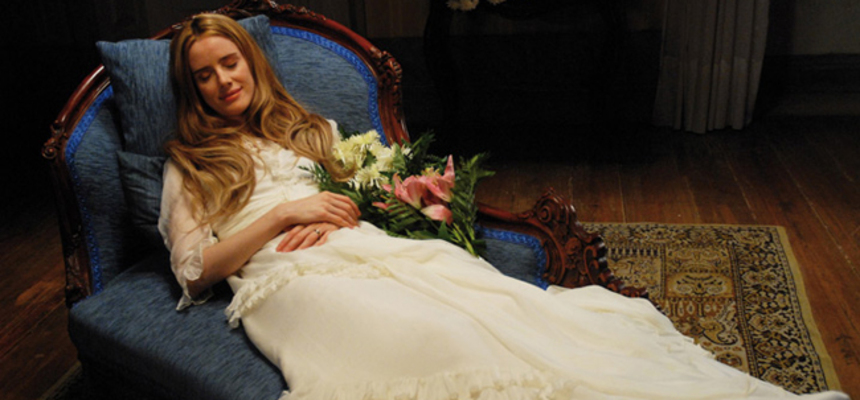NYFF 2010: THE STRANGE CASE OF ANGELICA Review

Moreover, its strangeness,
despite the title, does not derive so much from its subject matter but
from its deadpan insistence on its own littleness. Recalling the shrinking
of the moon down to a pocket-sized bauble in Despicable Me,
The Strange Case of Angelica feels like a part-whimsical, part-magic-realist
feature film that has been abridged to a short--then blown up again
to 90 minutes. In the process we seem to have lost certain kinds of
details, making this mildly supernatural allegory both pared down and
quirkily meandering.
Telling the tale of an old-fashioned
photographer (meta-commentary alert!) who becomes obsessed with the
recently departed title character, the film doesn't come across as
minimalist as much as miniaturized--not a statement of "less is more"
but a rhetorical question asking, "What else could there possibly
be anyway?" Each scene is shot in an exceedingly straightforward way
with a static camera and a plainly diagrammatic approach to mise-en-scène
that creates the odd sensation of our having stepped inside a film discovered
in an attic trunk somewhere. Sure, there are some amusing, even disarming,
touches here and there, but when push comes to shove, Oliveira seems
to value a stance of philosophical coolness over any overt attempt to
be charming: it's as if Fritz Lang had directed a Maurice Sendak
picture book. Our enjoyment, when it comes, is not from immersion in
the narrative material but from our calm appraisal of it, much like
we'd admire a nineteenth century volume of woodcut engravings.
I don't think Oliveira intends
for us to have these kinds of associations, however. His compositions
are far too painterly, especially with their Old Masters approach to
using light sources for symbolic effect. Sometimes this achieves wonderful
results, as when the photographer (Ricardo Trêpa) first encounters
the dead Angelica (Pilar López de Ayala) and she is presented as the
brightest, most lively element in the shot, her grieving relatives outlined
like shadowy wraiths in the background. This scene, and others like
it, might be haunting (double meaning intended) except that they're
often presented with a flatness that's not just intentional, but exaggerated.
In this way, the film unfolds cinematically like a series of understated
still-lifes, mourning tableaux, and Courbet-like peasants-working-the-fields
canvases hung on a gallery wall; our job, apparently, is to nod and
murmur something appreciative or at least polite about each one of them
before moving down the line. And yes, I'm aware that this is the third
time I've compared The Strange Case of Angelica to work in
other media, but that's the kind of film it is: as if, with
the exception of Oliveira's own eight-decade long oeuvre, its antecedents
lie in other cultural touchstones, not film, and certainly not in anything
in the horror or paranormal romance genres.
When we're done with the
exhibition we're sure to feel warmly for certain sequences, certain
shots, but we can't help noticing that the overall goal of creating
an otherworldly atmosphere has been consistently undercut by the truly
lame computer process shots. These boast a sub-Blue's Clues
interactivity between the lead and his spectral love interest that is
believable not even for a single second. Some audiences may feel that
the playful imagery that envelops these characters, and the gauzy aura
that surrounds Angelica, is modestly enchanting. To me all the shots
of Angelica-as-ghost are far too slick and precise, while their origins
in post-production tech are too crudely obvious. With its long takes,
piano-only score, and mannered acting, The Strange Case of Angelica
seems like a contemporary silent film--the sudden presence of intertitles
would not at all be shocking. But that's not the problem with the
film; that's one of the things that makes it interesting. The problem
is that the real masters of silent film, Lang in Destiny and
Murnau in Faust, for example, knew how to use special effects
and optical processes to create imagery that really did feel transporting
and magical. Oliveira, by contrast, gives one the impression of an artist
who has found some new toys to play with but hasn't quite mastered
them yet.
Wed Oct 6: 6:00pm (ATH) Ticket Info >>
http://www.filmlinc.com/nyff/2010/the-strange-case-of-angelica-o-estranho-caso-de-angelica]
The Strange Case of Angelica
Director(s)
- Manoel de Oliveira
Writer(s)
- Manoel de Oliveira (screenplay)
Cast
- Pilar López de Ayala
- Isabel Ruth
- Luís Miguel Cintra
- Ana Maria Magalhães







